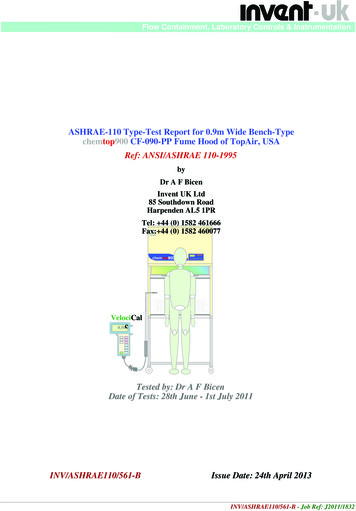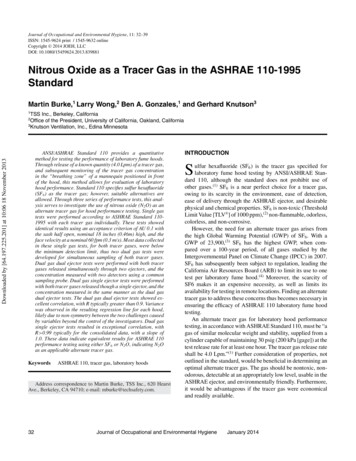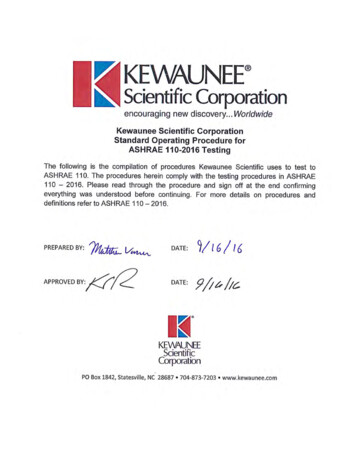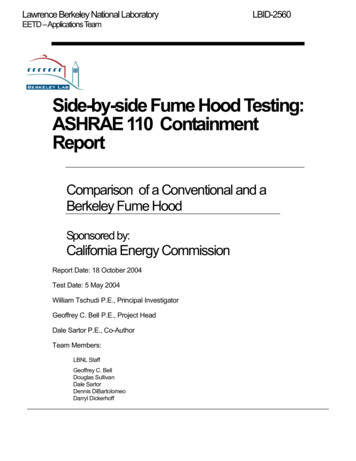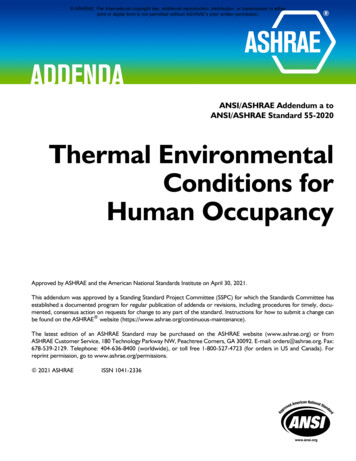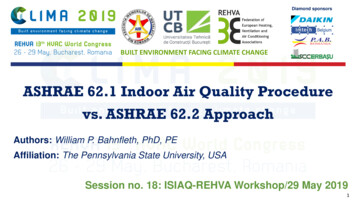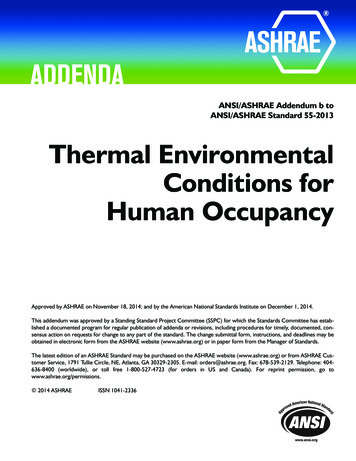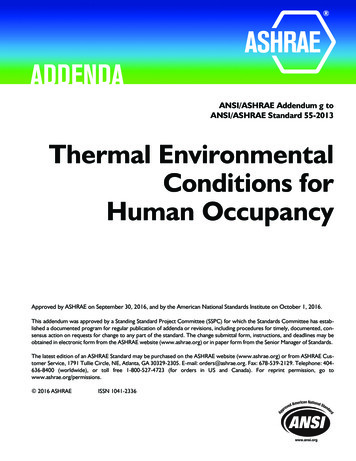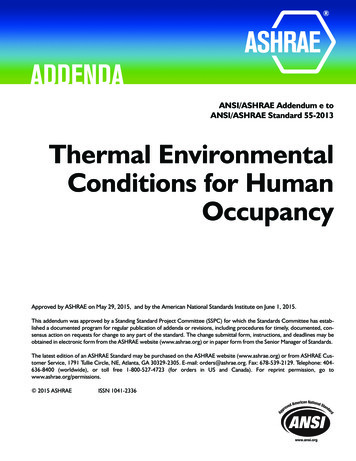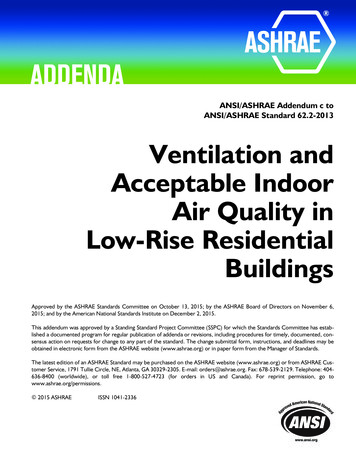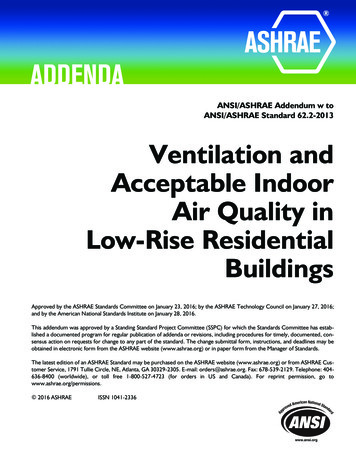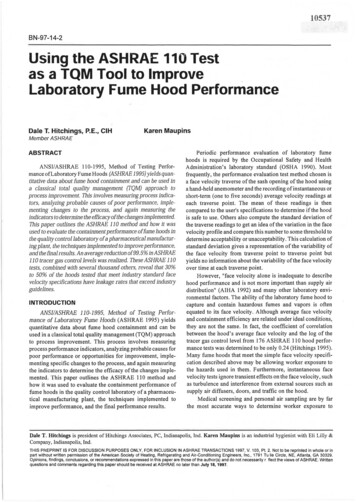
Transcription
10537BN-97-14-2Using the ASHRAE 110 Testas a TQM Tool to ImproveLaboratory Fume Hood PerformanceDale T. Hitchings, P.E., CIHMember ASH RAEKaren MaupinsABSTRACTANSI/ASHRAE 110-1995, Method of Testing Performance ofLaboratory Fume Hoods (ASHRAE 1995) yields quan-titative data about fume hood containment and can be used ina classical total quality management (TQM) approach toprocess improvement. This involves measuring process indicators, analyzing probable causes of poor performance, implementing changes to the process, and again measuring theindicators to determine the efficacy ofthe changes implemented.This paper outlines the ASHRAE 110 method and how it wasused to evaluate the containment performance of fume hoods inthe quality control laboratory ofa pharmaceutical manufacturing plant, the techniques implemented to improve performance,and the final results. An average reduction of99. 5% in ASHRAE110 tracer gas control levels was realized. These ASHRAE 110tests, combined with several thousand others, reveal that 30%to 50% of the hoods tested that meet industry standard facevelocity specifications have leakage rates that exceed industryguidelines.INTRODUCTIONANSIIASHRAE 110-1995, Method of Testing Performance of Laboratory Fume Hoods (ASHRAE 1995) yieldsquantitative data about fume hood containment and can beused in a classical total quality management (TQM) approachto process improvement. This process involves measuringprocess performance indicators, analyzing probable causes forpoor performance or opportunities for improvement, implementing specific changes to the process, and again measuringthe indicators to determine the efficacy of the changes implemented. This paper outlines the ASHRAE 110 method andhow it was used to evaluate the containment performance offume hoods in the quality control laboratory of a pharmaceutical manufacturing plant, the techniques implemented toimprove performance, and the final performance results.Periodic performance evaluation of laboratory fumehoods is required by the Occupational Safety and HealthAdministration's laboratory standard (OSHA 1990). Mostfrequently, the performance evaluation test method chosen isa face velocity traverse of the sash opening of the hood usinga hand-held anemometer and the recording of instantaneous orshort-term (one to five seconds) average velocity readings ateach traverse point. The mean of these readings is thencompared to the user's specifications to determine ifthe hoodis safe to use. Others also compute the standard deviation ofthe traverse readings to get an idea of the variation in the facevelocity profile and compare this number to some threshold todetermine acceptability or unacceptability. This calculation ofstandard deviation gives a representation of the variability ofthe face velocity from traverse point to traverse point butyields no information about the variability of the face velocityover time at each traverse point.However, "face velocity alone is inadequate to describehood performance and is not more important than supply airdistribution" (AIHA 1992) and many other laboratory environmental factors. The ability of the laboratory fume hood tocapture and contain hazardous fumes and vapors is oftenequated to its face velocity. Although average face velocityand containment efficiency are related under ideal conditions,they are not the same. In fact, the coefficient of correlationbetween the hood's average face velocity and the log of thetracer gas control level from 176 ASHRAE 110 hood performance tests was determined to be only 0.24 (Hitchings 1995).Many fume hoods that meet the simple face velocity specification described above may be allowing worker exposure tothe hazards used in them. Furthermore, instantaneous facevelocity tests ignore transient effects on the face velocity, suchas turbulence and interference from external sources such assupply air diffusers, doors, and traffic on the hood.Medical screening and personal air sampling are by farthe most accurate ways to determine worker exposure toDale T. Hitchings is president of Hitchings Associates, PC, Indianapolis, Ind. Karen Maupins is an industrial hygienist with Eli Lilly &Company, Indianapolis, Ind.THIS PREPRINT IS FOR DISCUSSION PURPOSES ONLY, FOR INCLUSION IN ASH RAE TRANSACTIONS 1997, V. 103, Pt. 2. Not to be reprinted in whole or inpart without written permission of the American Society of Heating, Refrigerating and Air-Conditioning Engineers, Inc., 1791 Tu lie Circle, NE, Atlanta, GA 30329.Opinions, findings, conclusions, or recommendations expressed in this paper are those of the author(s) and do not necessarily r fleet the views of ASH RAE. Writtenquestions and comments regarding this paper should be received at ASH RAE no later than July 18, 1997.
hazardous substances used in fume -hoods, butthey are frequently impractical due to the time and cost involv!!d insampling each worker'at each hood for eac;h agent useq in t,hehood and re-testing when new agents are introduced or newprocedures implemented.'' ·, .' . ' I j,f'"' '' ''"I'Il.In the late 1970s, qaplan and nutso l began publishing.' .t·.'· research using a n w method f e ern ·ning capture .effi.r I 'J'cieocy by using a trac r gasi' sampliu met od CGaP.lan andKnutson 1977 1978). This was the P.tecursor tf) AN. YASHRAE I io-19µ5,.Metho4 'f.estipg P rformane,e,of L' bo ·;·a.tory Fume Hopas'and the '199S yersion ofthe standard. The11 ra ersio 10' pie revis.ed st ?d 1rQ :i-vas us. a t;he ,b J.Si . ortl\e tracer gas containment test ng cited i,n his p,aper., Mpdifi··ditions and ephan ment1s' weie \ll(l,deth is test protpooleither td 1s.implify the procedure and make it more C(:)st-effec'ti ve o p rform cir tO enhance the results.One ofI these enhan' e ments is the u'se 'ofreal-'time data acquisition ofvelocitv dataat e'ac11 'traveFse point 'and the applicati :m of statistic L tech' f .,l I,,'ni(j ues to give a more a curate picture pf furpe hood per or\nance. Tl is technique reveals significantly more abolll thevariation ' of the face velocityover time and ( is explained ' inu .det ii elsewhere in this paper in "The AN T(A 1-JR, E 110Test 'Method." ASHRAE 110 testing is also recommended inthe newly revised Prudent Practices in the Laboratory (NRC1995). The OSHA laboratory standard hea ily referen es the1981 :version' bf this excellent work and implies adherence toits recorrfrriendations (OSHA 1990).,.( .!oftor· 1c;ompl {nts fi: m laboratory. worker's and oiw, rns abou,tpotential exposu res to agen leak ing fr.om old fume hoods .i,nan oid iaboratory facility provided the motiv tion to iq esthgate and mitigate the situation . Some personal air samplingwas done, requirin'g consid,erabll\ time and ense . qwcrx-er,a cortiprehens'i es i.1dy of this type involving.all work.ers andall agents ' uslii,g his etliod' p oved im r ctital, and ,'tr'adi:ti on al face velocity testing oflioocfs proved inadequate to evalu·a'te a·ctual fume ho9d perfo ni n.ce (contaitlment); AS ;;i. E110 fosting as chose { .the rho' t cost-effective method' ofdettmhining quarhitative ·fum e 110.o'd pertormahce and the1results e 'usedl'a the basis' a project that i vo lved dia Tlosing1hood00COI tain. ent rollle'ins, iQ.bnhfying solutio s tothen'1, and impl'C i:nei tlli{those· solutions.'fo reduce potentialwo ker exposnre . ·/. I6f. ,,II 1t.·"l'-1THE LABORATORYI\1. I,;I1IIIlj ,·1fAC'i'tfrv) ")I'."ITbe:aubject facility is: ari'arialytical laboratory for a fargemidwesteru. ph"rmaceutica:: ·mamifacturing pfar\J. Nine·fabd"ratories wen created hy renuvathi:gran exi'sting office/c feteri'ab.uHdinr mcire than 2C years ago.'There are 46 chemicaHu1'n:ehooc.ls,;with individual exhawiHans at1'd stacks. '"·'i . ,,· . h rke au .un:s '. f s lvei.1ts are -ed ,i,n 'the laboratprie: 'and seve al-d 1ffer'en l vrod.ucts ·of vary l ng potency are tested uitlfom!; some of'. whic e'. severe a'ltergens". A "potent';.cvrr1'{: 6uud ' is one that prdd!JCC : sign ificant . phy !ologi . Ieffetts. irt very. i6\v e,x·posure conc'enttation.s: ''Se- ere al/er. r:rr. '2"'j:·-.;,Jj; ,. I l1(), .qJ' I'',Jll F,igu ,r; 1. The classical·J:QM process. · ·1. J'geps" a compounds that can produce serious undesirableeffects ip. susc,:eptiblt;;in ividuals.11 11',,,.'IHIE PERFORMANCE lllJIPROVEMENl :PROCESS·, . ! r,' .,· ,''' ' ''A classical TQM approach was used in the planniqgexecution of this project (sec Figure 1). ' \'. 1.;; .',I!'rI nd'BaseliM performance was first deterr;iined by testing al: 46fume h.oods using the ASHRAE 110 method.'1;."' 12. · · Probable causes of poor performance .were determined. ·.:\3.Solutions were generated for most- of the problems determined-in step!2;: · ·,r)\ - '· ., "· .,, .4.A mitigation plan was i plemented that. included the. splilI ,. .· '' .tlons m step 3. . II. -i ., i'. ·, '.1 I'I ! The pro ess w:as then e.ompleted ,!Jy n::i:jsting the . fumeand·compai:b.g the preo and post-mitigation i'es:i:liH :tbdetermine :th!l effectivene3s c fahe. ;oroject. :irI; oodsl ; i". -THE ASHRAE 110 1995 TEST METHOD (MODIFfED).i;'\jFlow Visualization (Smoke Testing)!lLow,-Vo ,umc; Smok-e Te t. A' sma.!t;f,mouht of whitesmoke was produced. by usiQg a ,gla&s.smoke tube/bulbrarrangement, ana/Or a swab of titaniu.111 te.tra hloride. '1i.al , ·r I ,l. , sluoRe. source wa, . moved aro md 1 th . periwet r oft s sh.o erii g hire ob1serving th . ow pa,u rns,., ! 1 hpq9§·P.!1s eqthr.s f st tf 10 fl .w-r,everna l s or ddy rr n . w. re, det ectc;d1and· if no smoke escapedtt,fromf tbe I(hood·ntotl e.lat oratpq - ':"Flow .r versals" ar:1d "eddy-c:;urren:s-'.', are l,oc a,li z d, phe o.- ena In wh i c tlie dfre tion offlRw·is-contr fY to. ql e ? ev.ai \ .&streamlines, and they are often characterized by turbulenceand vortices. '. · .''' 1, "., aI', t.I 1' I 1· l '.'I ;·!ff.II ; 1·.; , IJ ; no1.1nts: nfsniok,e werr" g: n, rated u 1g a theatrical Sill; Ir: e11 rater. 'IjJ;i cS)ll O e 1W r,el,ea ed at a low velocity nt the .fu rn ,, ootl omthe end of a flex ihle hose, nd t}Je flow pattern . were pb . er er.The; hRocJ 1 p,as eq .this tes.t if1 o. s.rook scapet;i froi:n the ,h;:i .'dwith 41 - ei,ng 1 il]lm ed iat y rer ?gture ., , , :. . High: V; lumc fi?.p.ke · Cliallenge. Copiou t
Real-Time Face Velocity AnalysisJ1'.Hardware. The test W.as perf )rmed using a hot-wire typeof velocity transducer that'produdlls atl. analog signal proportional to the ai1; · velocify lt' t\1e r-obe. Tv;is transducer signal1was used as the klput to a. pro(;'riet!l'ry data a6Eiuisition systemthat performs signai c uditioning nd analog tqdigital conversion. These cijgira,1 data were sdalea aftd offset to producevelocity d ta ·jrf' l'lgirleerin unif s a d .then1c·ollected using acomputer run rung. p Qpnetary software for analysis.Calibration 1rrid. A ur b'.- fr:he transducer was factorycalibrated using instritrrlentation whose accuracy was traceable to National Institate of Standards and Technology (NIST)standards at STP (standard. emper'atur.e· of 21.1 C and pressure of760.00 mm Hg). The velocity instrument was accuratet'o 1.5% ofreading '61" 1.5 fpm at 100 fpm ( '.008 mis attfS 1mis). The accuracy of the signal ctmditioning equipihent knaanalog to digital conversion hardware was 112 bit of an 8-bitword ( one:p·art.in 2'66), or 0.4%:W.ggre ate'shtem errors w re7xrected to be le s t,ha 'Yo . r 2 fpw at 100 fpm (0.01 mis atlo i5F I)r. . . '· r,. .ms.i·1 . ; ,'''·it' \,, .Procedure. The sash ofienin'g was divided into an imag!inary grid of ap.proXJimately one·-foot dimensiorts, and theprobe was placed in the! center of each grid box. The velocityprobe was positioned at the desired traverse point in the planeof the hood opening. Velocity readings w re taken five timesper second over a 30--second period·,pet traver e point. Theprobe was then moved to another location'until th entire sashopening had been sp vered;, For each position, the mean,irtakiriium, mirilin' m. ano standard deviation w re calculatedand recorded.; ;'"furor! Reduction. Investigator indu-0ed error caused byiIJiprQpQn locati n,"0rienta'tion; .or mi0,'veni '11t of the velocicyprobe during the traverse lTfas 'r.educed or efon'inated by clamp"ing the velocity transducer to a ring stand that could be accurateiy positioned in the plane of the sash'bpening of the hood.Instrument reading error was eliminated by having thecomputer read the output of the. insttum 1nt.ASHRAE.i.110 Tracer. Gas containment Testing;·Hardwa .'·!fiis'.'. e ( i'i P.e f'o.r .:eci' usi g , lef. r?"nca lure 'detecf'or type of fracer,. g s analyzer. Lt ,h -a !tgiJal tb d\ play reading b t in ppi;O 'and an alJ log ig ai outputthat ·es' to 4roprietary ata ac'ql!i \tion sys em that perf? mssignal1"c6rtdlifoi\iiig an'd 'na1og to 'oigital conversio'n. Thesedi'g tlil &ata' . r -tlfon: c;: led 'f(set t? .P;rQ i ce. tra e, gasc'6Wdfotration d'ata in en ineeimg 1'.t'nits and t.hen collectedus·m g a' 'cbhl iii 'r "rifnHin ·prSp retary sofh'vare for. 11 1ysis. lVC' , . , . t., ,r"'),, The ' mannequin . used for the test is a clothing di p aY.mannequin that meets the height and width requirements ofA.SH E · irn1. 1The feef.vvbre'rrlo· liffetl '(temov·ei:i) so that themarinequiwt1n1r fl1e moutited on an elevated' 1Wobife.1 lafformyet ti 1".l fnlifnlaiil .!the nJight r&{u'ired . by Ile . dandaril. ' i !;'mledffleati'on is not' expected to affect%e ·tMst re h)ts. w h n ·used tl!s ing 1 beltttlitop' and 11distlllation1 ftlme"'hoqd' an1d is1expected to have Iittle effe'ct'w'l'ien testing\.iall '-ln'ttiine11l ods:an11. ,.: 'The tracer'gas flow rate to the A l-1RA E standard ejectorWa"S measu e\:l and co1ttrolled "to 4'. 0L/ry1in using a gas flowri;eter lria-' pres iJre gau e.a ''I \ !t'. 0I ,,. Calibration and Accuracy. :H l, electron capture celldete tionlimit in the particular configuration 1,1sed in this testw s· o·.o ·ppm. Tl e a'ccura y o
ANSI/ASHRAE 110-1995, Method of Testing Perfor mance ofLaboratory Fume Hoods (ASHRAE 1995) yields quan titative data about fume hood containment and can be used in a classical total quality management (TQM) approach to process improvement. This involves measuring process indica tors, analyzing probable causes of poor performance, imple menting changes to the process, and again .
